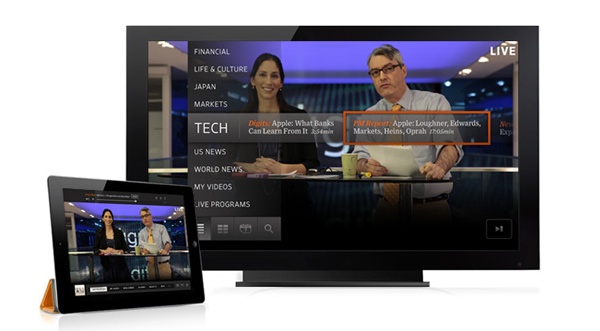
For The Wall Street Journal, it was just a change in an icon — but it signifies a larger shift in video strategy.
 Last month, eagle-eyed Apple TV users might have noticed a subtle change to their Journal app. Its icon, which for years had been the grey-and-green “WSJ Live,” was replaced with one reading simply “WSJ Video.” The change follows a May announcement by the Journal that it was canceling three of its scheduled live programs. The WSJ was becoming less “live” — a shift mirrored by other outlets.
Last month, eagle-eyed Apple TV users might have noticed a subtle change to their Journal app. Its icon, which for years had been the grey-and-green “WSJ Live,” was replaced with one reading simply “WSJ Video.” The change follows a May announcement by the Journal that it was canceling three of its scheduled live programs. The WSJ was becoming less “live” — a shift mirrored by other outlets.
Not that long ago, top news publishers were talking about wanting to beat TV to the punch on live online video. Newspapers had been disrupted when digital distribution opened them up to new competition, the theory went — wouldn’t television networks be open to the same sort of threat? Why couldn’t someone like a Wall Street Journal build an online successor to, say, CNBC? Outlets from The New York Times to The Washington Post to Politico all built out live programming with the aim of becoming appointment viewing for the deskbound information workers of the world.
Launched in 2011, WSJ Live was at the leading edge of the movement, heralded as a innovative product for the newspaper and hoping to take advantage of the tablet revolution. WSJ Live was pitched as “Original Programming, On Demand, Immediate, Relevant, WSJ Live brings influencers and decision-makers live news and on-demand video directly from 2000+ reporters across the globe.” Our own Ken Doctor enjoyed the product:At its height, WSJ Live was producing more than 4 1/2 hours of live programming a day, with shows like News Hub, Money Beat, and Asia Today. In 2012, it said had completely sold out available advertising slots on the app.It leverages the tablet-sized screen well. It mixes on-the-hour scheduled programming with on-demand access. It balances the talking heads of its global reporting workforce, via Skype, with anchor-hosted programs (News Hub), photo stills, and graphics. It is faster-paced than most news video, with some of the print-reporter geekiness at least acceptable and often enjoyable compared to the slick, no-surprise, Wolf Blitzer-me-to-sleep monotony of cable news. Within the business news world, it sits somewhere between the casualness of American Public Media’s Marketplace and CNBC’s button-down coverage.
But most live online news video efforts have struggled to find an audience. The Times killed TimesCast. The Post cut back severely on PostTV’s live programming. And the Journal has followed suit. Its video page still lists six scheduled programs, but only two have produced new material since May; together, they produce about half an hour of new live video each weekday.
Andy Regal, executive editor of video at the Wall Street Journal, said the branding shift doesn’t signal the final nail in the coffin for live video at the Journal: “We continue to stress live video. We are covering press conferences and live events all the time.” (The Journal’s iOS video apps are still branded as WSJ Live, but they haven’t been updated in over two years.)
But the larger shift is, as at other publishers, away from TV-style live programming and toward more slickly produced video available on demand. It’s a decision born out of a business imperative, says Regal. “People come to the Wall Street Journal when they have time, or need a break or when there’s a big event,” he said. “If we continue to try to drive people to appointment television, it’s just not a workable business model. That’s been proven by most who have tried it.”
Regal said video views are still rising: “Everytime someone comes to our site, they are watching more video. So we have to make strategic decisions.” As a result, the Journal decided to devote more resources to video to illustrate stories it is telling in more traditional formats. “We of course believe in traditional interviewing, but with better technology, infographics, and data we can tell stories more visually and turn them around quickly,” he said.
Regal points to a recent video about the DuPont board fight as an example of the type of creative storytelling that video is now capable of. “It’s a dry subject matter that we made visually interesting.”
Regal said he hopes the new direction will free the Journal’s video reporters and producers up to make interesting and valuable journalism. “We’re doing the same things, but now we’re not beholden to a specific time which means now we can do them when we want to.”
The Journal also bet on something called WorldStream, a product that featured short reporter-recorded videos, often from the scenes of news. While there was a initial push to make the product consumer-facing, Regal says that these reporter-produced videos are now largely being pulled into other videos that the Journal produces. A recent look at WorldStream shows only seven new videos have been uploaded since June 1; Journal journalists were filing about 12 videos a day in the first few months after launch.Regal said further tweaks are planned for the WSJ.com video hub, including improved navigation: “From the top level, The Wall Street Journal sees the importance of digital storytelling. We anticipate that engagement continuing to grow.”
While traditional publishers have scaled back live video, that doesn’t mean they’re investing less in video overall, even if financial results have often been disappointing. Online natives like BuzzFeed, Vox, and Quartz are betting on video in ways big and small. (“It’s way too easy to produce mediocre video, and to lose money on digital video efforts,” Quartz editor-in-chief Kevin Delaney wrote recently. “Any honest assessment of media companies’ current non-TV-originated internet video would reflect that.”)
One company is moving in the opposite direction on live video: The Huffington Post, which has bet big on its two-year-old HuffPost Live. Last month, Arianna Huffington announced that it would grow into a 24-hour video news network called HuffPost 24 which will be available online and through mobile apps. It’s part of a strategy which eventually will see video as 50 percent of all content on the site.